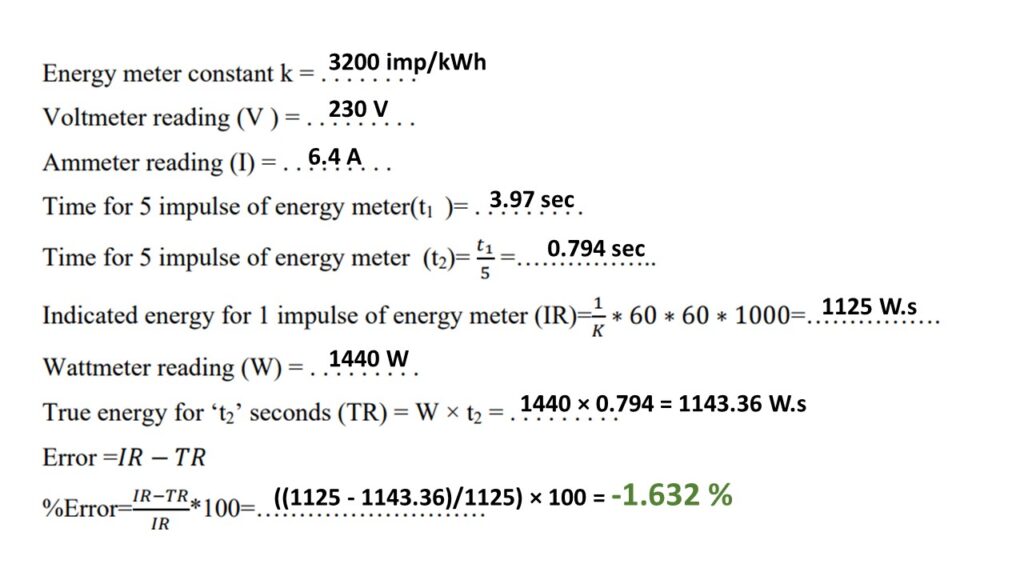Experiment No.: 5
Experiment Name:
Calibrate single phase electronic energy meter by direct loading.
Objective:
To calibrate single phase electronic energy meter by direct loading using resistive load.
Theory:
An energy meter is an instrument used to measure electrical energy. It keeps a record of the total energy consumed in a circuit during a particular period. It is an integrating type of instrument. Calibration involves comparing the energy measured by an energy meter with a standard instrument. The standard chosen here is a wattmeter. Since the wattmeter measures only the power, it has to be multiplied with time to get the energy reading. The readings are then compared to find the error in the energy meter. Calibration can be done either by direct loading or phantom loading. In direct loading both the current and pressure coils are fed from the same supply at rated voltage. Energy meters of high rating when tested by direct loading would involve large amount of power. Such meters are thus tested using phantom loading, wherein the pressure coil is supplied from rated supply and current coil circuit from a separate low voltage supply.
Circuit Diagram:

Procedure:
- Connections are made as shown in the connection diagram.
- The supply is switched on, keeping the autotransformer in the minimum position.
- The autotransformer is then varied to get the rated voltage.
- The lamp load is then switched on and the ammeter reading adjusted for a small value of current.
- The corresponding readings of voltmeter, ammeter and wattmeter are noted down.
- The time for five impulse of the energy meter disc is also noted.
- The experiment is repeated in steps adding loads till the rated current of the energy meter is reached.
- The true energy and indicated energy is evaluated and the error found out.
Observation Table:
| Sl. No. | Voltmeter reading (V) | Ammeter reading (A) | Wattmeter reading (W) | Time for 5 impulse, t1 (s) | Time for 1 impulse, t2 (s) | Indicated reading, IR (W.s) | True reading, TR (W.s) | Error (IR-TR) (W.s) | % Error |
| 1. | 230 | 6.4 | 1440 | 3.97 | 0.794 | 1125 | 1143.36 | -18.36 | -1.632 % |
Calculation:

Apparatus Used:
| Sl. No. | Name of the Apparatus | Specification | Quantity | Makers name |
| 1. | 1-Ø & 3-Ø energy meter calibration study kit | 230 V, 415 V | 1 | M.E.W. |
| 2. | AC 1-Ø Static Energy meter | 240 V, 50 Hz, 5-30 A, 3200 imp/kWh, electronics | 1 | KEI Electric and Electronics |
| 3. | Voltmeter | 0-500 V, MI type | 1 | Sushma |
| 4. | Ammeter | 0-10 A | 1 | Sushma |
| 5. | Wattmeter | 150-300-600 V, 0-750-1500-3000 W, 5-10 A | 1 | MECO-G |
| 6. | 1-Ø load box | 1.5 kW, resistive load | 1 | |
| 7. | Timer | Smart phone used as timer | 1 | Samsung |
| 8. | Connecting Cables | Cu- conductor, 2.5 sq. mm., 1100 V grade, PVC, FRLC | As required | Maru |
Result:
There is an error of -1.632% in the used energymeter.

Sir Quantity has been replaced by specification
Post updated. Thanks for correcting.